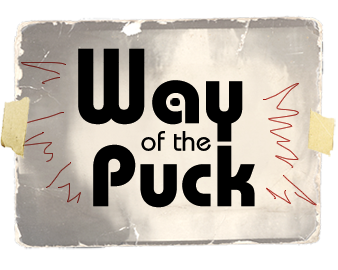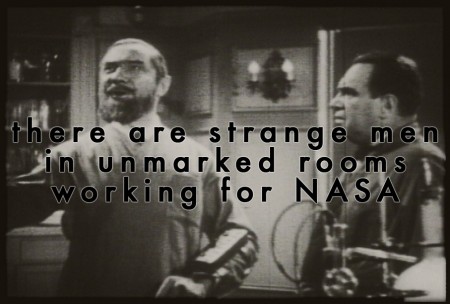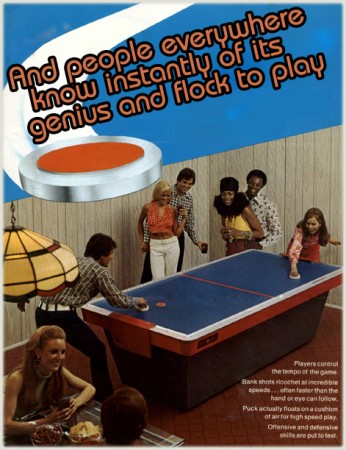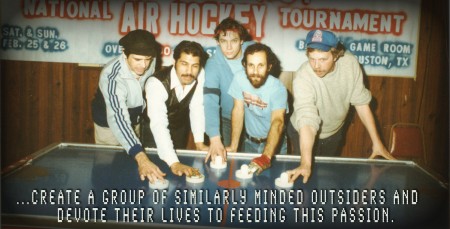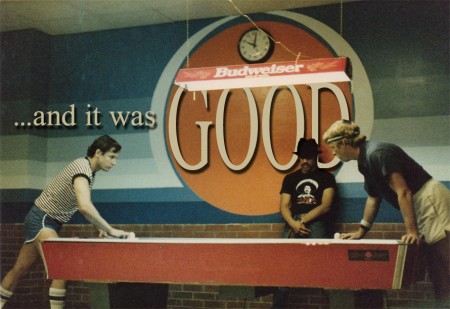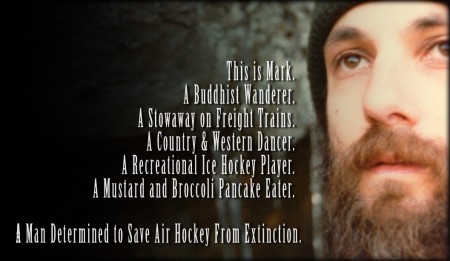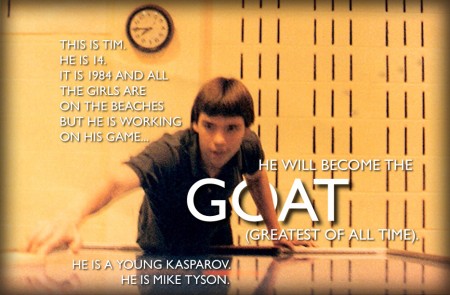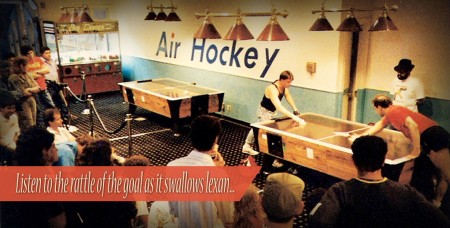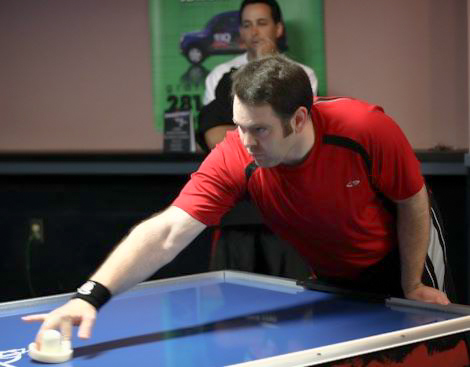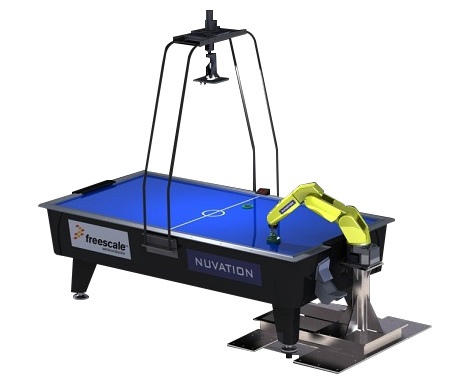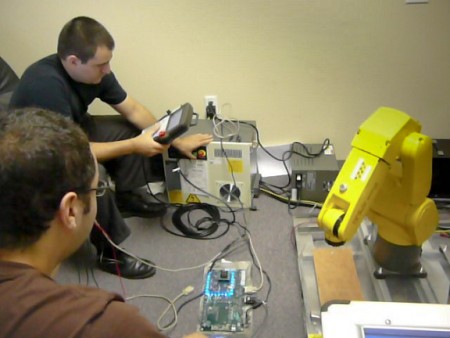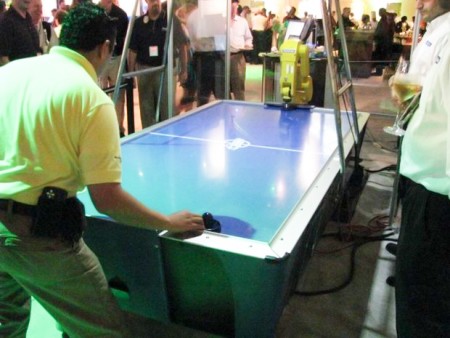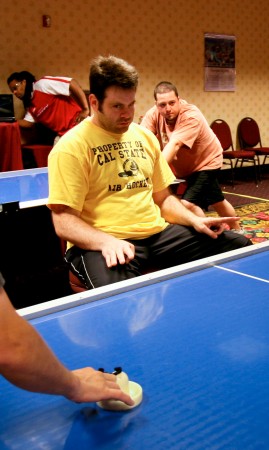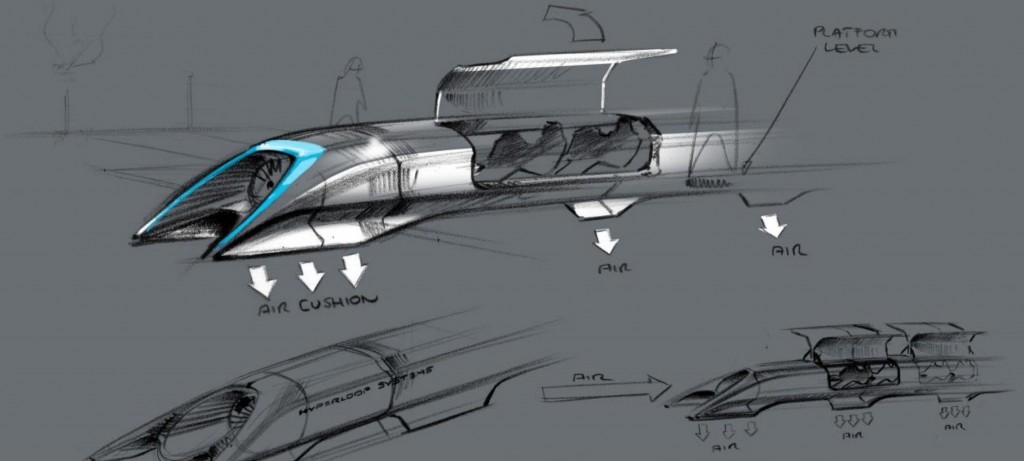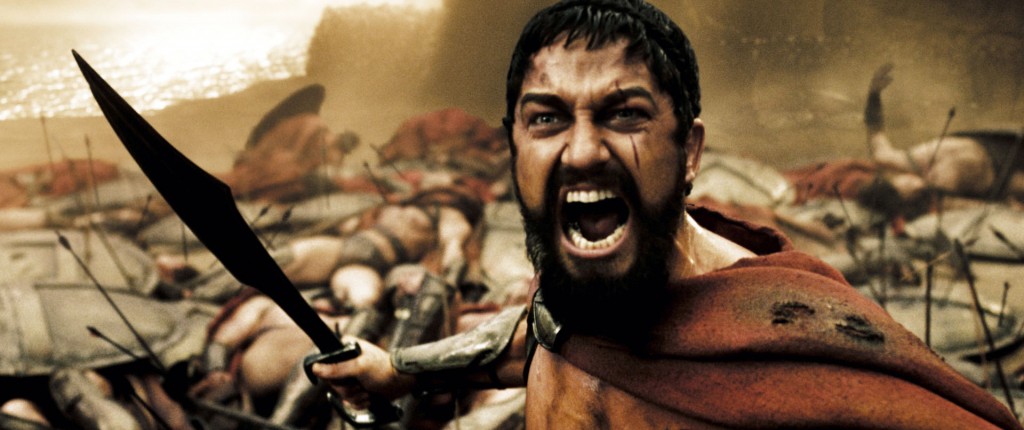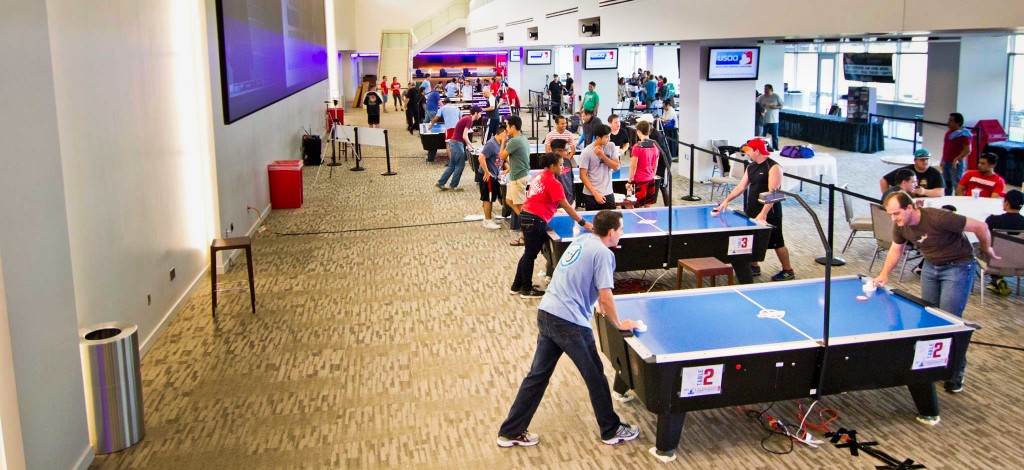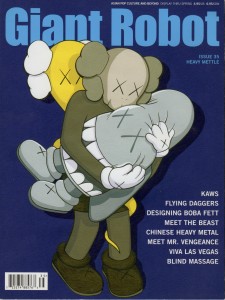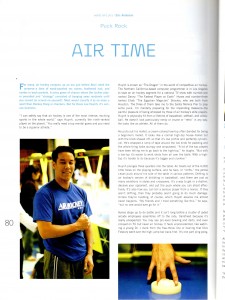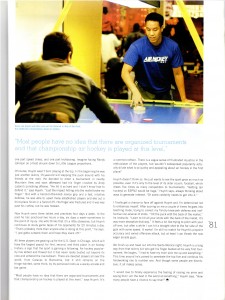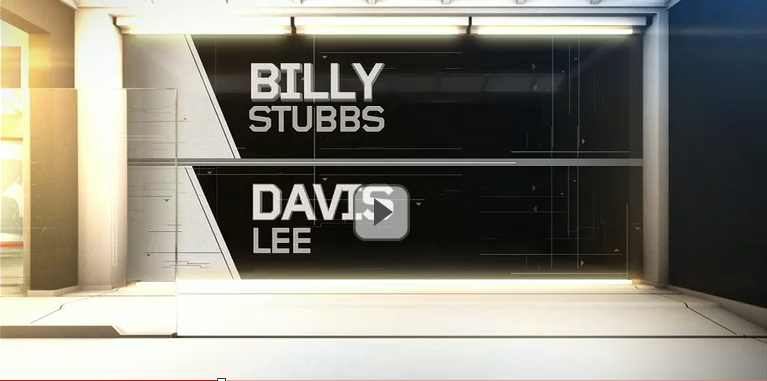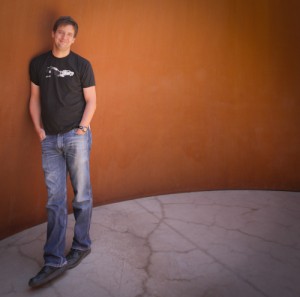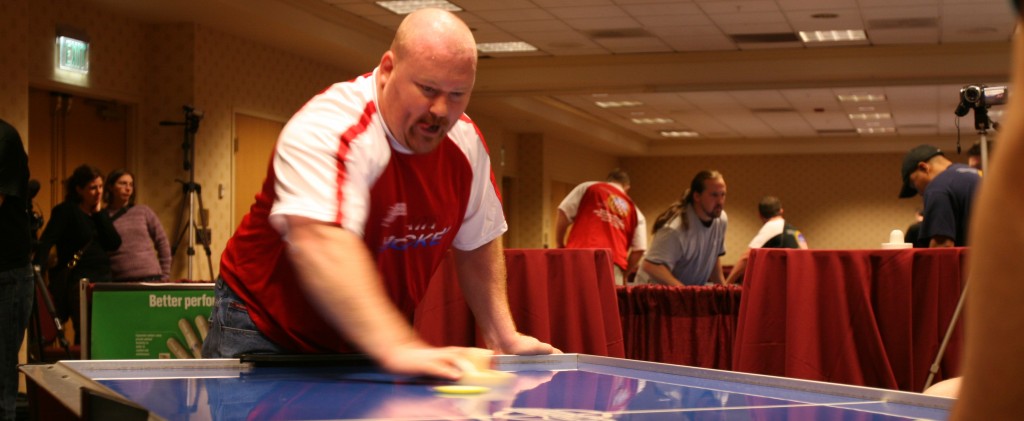The Story of Air Hockey
“Before everything there is the Cold War. There are experiments with hovercraft and frictionless environments…”
Way of the Puck begins at the World Air Hockey Championships in Las Vegas, Nevada, where we are introduced to Andy the Promoter, Tim the 10-time World Champion, and Mark the Air Hockey Guru. For all intents and purposes, this is the beginning of our story. But what about what comes before this tournament? Is some kind of backstory required to get viewers up to speed?
We’ve created a short visual essay about the history and mythology of air hockey as a companion piece to the film. In order to understand and appreciate the passion of these men who devote their lives to a forgotten arcade game, we must start at the beginning. The very beginning. Let us take a brief trip through the decades that come before the beginning of Way of the Puck.
Click on any of the frames below to be whisked away to the Story of Air Hockey, otherwise known as our Scrapbook, or just the plain old Backstory!
Joe vs. The Volcano: Improving the Deep Blue of Air Hockey
Air hockey and robotics have a rich history. From the humanoid stylings of DB in Kyoto, Japan, to the mechanics of Professor Mark Spong’s air hockey robot at the University of Chicago, to the latest and greatest hack cobbled together with 3d printer parts, engineers find the air hockey environment to be a useful arena in which to develop autonomous robots. As a bounded, two-dimensional playing surface, with four reflecting rails and a single puck that’s batted around, the air hockey table limits the chaos coming at a newborn machine and allows it to master things like tracking, prediction, and reaction. Like many things, however, air hockey is deceptively simple to learn and punishingly difficult to master.
In 2008 game designer Joe Cain was invited to the offices of Nuvation, an engineering firm in the Bay Area, to test an air hockey robot they were developing for the Freescale Technology Forum. Cain was the number two ranked air hockey player in all of California. The following is his account of playing this robot designed to crush all humans in its path—the Deep Blue of air hockey.
By Joe Cain
Game testing is something that very naturally just comes to me; it isn’t even something I have to think about. For some reason I have an innate ability to conceptualize this stuff, like: “I see the way these dominoes are stacked up. If I do this thing that somebody’s not expecting me to do then something crazy is going to happen.”
So when I heard Nuvation was trying to find somebody who knew a little bit more about air hockey than your average engineer, I was interested. I was still working for Electronic Arts at the time and my schedule was pretty flexible so I went down to their office, which was in this weird area where San Jose and Milpitas meet up, two blocks away from an old apartment complex I used to live at. I wasn’t so sure what to expect.
I hit the buzzer and project lead, Mohan Gurunathan, took me back to a room with one or two other lab guys and said, “We really want to see if you can do some damage here to the robot. We feel like it’s pretty good but we can only do so much.” They had this robotic arm set up on the other side of an air hockey table. There was a whole apparatus up eight to nine feet above the table with a camera pointing down—it looked like an overhead, but really tall. There was a puck covered with reflective tape and there were some computers around. And on the monitors there was a representation of the table, so as the puck was being knocked around it was projecting what was going on by drawing vectors on the screen.
I kept looking at this and going, “Whoa, what’s going on here?” I wasn’t sure what they were up to exactly. I wanted to understand if this robot would react the same way a human would react or if it would do something different. I figured a straight shot probably wasn’t going to score. So I just thought, “I’ll do my normal drift, my little diagonal drift and then I’ll try to shoot a bank.”
So I drifted the puck up and almost at the centerline I punched at it with my back of the mallet and did a right-wall-under—and the arm didn’t move! The robot didn’t flinch! The puck went in and all of a sudden everybody in the room just kind of stopped—they were totally expecting the robot to block my shot. They said, “Wait, wait. Hold it. This can’t be right.” I almost felt like they were going to look and see if the arm was actually plugged in or not. Like: “Is this thing on?”
Finally, they said, “Let’s reset and do that exact same thing you just did.” So I set up, I did the exact same drift—same bank shot—and boom, I scored again. All of them were stunned and looking at each other like, “What is this guy doing?”
Well, they weren’t accounting for a drift. A lot of novice players sit behind of the puck and wiggle their hand—trying to psyche their friend out—before making a shot, and I think this is the kind of gameplay the engineers expected. They had done all of their modeling off of a stationary puck so when I drifted the puck the robot thought it was a shot. And actually, had I not redirected the puck the robot would have been in perfect position to block it—but once the robot had made a decision it couldn’t adjust. Also, the puck had to be shot at a certain speed and from a certain location; they assumed a person would probably shoot the puck from further back on the table and I was releasing much closer to the centerline.
So they made a few changes on the fly, really quickly. They moved the recognition point of a shot to further up the table and they figured out a way to determine whether something was a shot or a drift based on its speed. The robot definitely improved but it was still rough around the edges. They said, “We sort of hacked this together really fast as a result of what you just did. Give us a chance to go back to the drawing board.”
A few months later they invited me back. They were planning to put the robot in some science and tech museums around the world so they wanted to make sure it was ready. It was clear that they had isolated some weaknesses and it was actually getting difficult to score. The robot was really good at defending stationary banks and it had gotten much better at reacting to the banks when hit off a drift. But perfectly executed straight shots and chase shots still gave it problems. If I hit a Goran-style [player Goran Mitic] chase shot off-goal and then let it come back and hit my back rail before redirecting it at the opposing goal as a cross or a bank, it couldn’t stop it.
Another odd thing: Off-speed shots were also working, which I found really weird. A couple of times I hit a slow straight shot right down the middle and the robot arm actually moved completely out of the way. It didn’t know what to do. It’s as if it was thinking, “Hey, is that a shot? Is that not a shot? Where do I go?”
But by the time I went back for the third time they had really shored up a lot. Well, with the exception of a fast perfect bank, or a weird deflection, it blocked pretty much every bank, stationary or drifting. It’s pretty impressive that they were able to perfect that part of it. It was probably on the border of an expert- to pro-level defense then. I actually think this robot understood things about air hockey that many players don’t understand, especially in regards to spin. Nuvation had figured out a predictive algorithm that took spin into account and how it changed trajectory, completely without me saying anything. So that was interesting. But it still couldn’t stop a chase shot. To this day it can’t stop that. The robot just can’t handle it. The chase shot kind of blows the robot’s mind for some reason.
It can’t really play offense either, but none of these robots can. The best offense it can achieve is kind of a defensive batting back; it reads where you are going to shoot and then tries to be in that position to punch it back at you. The guys at Nuvation were experimenting with pistons—basically they chunked out a part of the front of the mallet and they inserted a piston with an air compressor. In order to shoot, it would position the mallet behind the puck and then activate the piston and then the piston would push out this piece of the mallet and shoot it forward. But even that was pretty weak.
It’s probably okay though because what I’ve often noticed is that against robots people just score on themselves! They find they can’t make an easy shot so they try to overcook something and the shot bounces back funny and they score on themselves. They probably beat themselves more than anything.
Eventually though, what you could do with this robot—if it improved enough—is program different playing styles and abilities into it. Maybe this is just the game designer in me. The robot’s behind Plexiglass so the mechanism’s protected, right? You can’t mess with it; it can’t hurt you. Then you put a video stream up and have a character of a little girl or a sumo wrestler or a ninja or a karate expert as if that’s the robot’s persona. And it’s taunting you, saying, “Hey, come on there. Try to score on me!” You could play against a super-terrible newbie with no reflexes or against the world champion Colin Cummings. Or against Colin Cummings as a 10-year old prodigy ready to kick your ass! I think somebody could pull that off—using this technology to entertain.
Either way, it’s eye opening to try to understand this puzzle Phil and Mark and Billy [players Phil Arnold, Mark Robbins, and Billy Stubbs] have been trying to deconstruct for so many years. And to watch the guys at Nuvation go through it from an engineering mindset. Air hockey is just not a perfectible thing. Even for a robot. There’s too much randomness. There are physical things that happen with a puck that you can’t predict. How many times have I tried to block a puck and I block it perfectly and it still ricochets in a weird way and scores on me anyway? No amount of raw computing power can overcome that.
Especially on a chase shot!
Editor’s note: We contacted Nuvation and learned that they were finishing up a smarter, faster, next-generation version of their air hockey robot. We tried to arrange a rematch between Joe and the robot, but the unit needed to be shipped to a science museum on the east coast. We can only speculate about its “much improved” skillsets and if it can compete with Chiba University’s robot, which is apparently intelligent enough to adjust its long-term strategy based on its opponent’s playing behavior. Maybe next time we’ll leave humans out of it altogether.
◊◊◊
Bad News Bears
Best air hockey scene in a movie, ever.
10-Year Anniversary of “Air Time”
We have just passed the 10-year anniversary of the article “Air Time” written by Way of the Puck director Eric D. Anderson. The article was a direct result of that very first encounter with the air hockey community in Fremont, California at City Beach. Players Davis Lee Huynh, J. Hilton Reed, and Harvey Thornburg introduced Anderson to competitive air hockey, while informing him that the world championships were only a week away in Las Vegas. That evening was impactful enough to compel Anderson to head to Las Vegas with a camera crew to find out if there was an interesting movie in all of it. Hard to believe that was ten years ago!
The article was a follow-up with Huynh—then ranked a distant sixth in the world—and his mission to win a world championship. Huynh eventually did win two championships (in 2007 and 2010), but at the time his ambition seemed like pure fantasy.
Giant Robot magazine no longer exists so we scanned the article for all of you air hockey heads out there!
Rise of the Machine: An Interview With World Champion Billy Stubbs
Billy Stubbs is a 39-year-old creative director based out of Chicago, Illinois. He started playing air hockey seriously in 1993 while living in Georgia, trekking up to Atlanta every weekend to play with eleven-time world champion Jesse Douty. After finishing 48th in his first national tournament, he decided he needed to practice even harder and dedicated himself to systematic, rapid improvement. The following year he placed fifth, a result that raised eyebrows, and in 1995 he came out of nowhere and rolled through a deep field—beating champions Tim Weissman, Jesse Douty, and Wil Upchurch en route to his first national championship. He was twenty years and six months old, the third youngest champion of all time. Although some predicted that youthful Stubbs’ disciplined, analytical approach would deliver him several championships in the 1990s, he went seventeen years without winning another one. In 2012, at the tender age of 37, he finally became world champion again, prevailing first in Las Vegas and later in Houston that year. He won his fourth world championship in 2014.
Stubbs plays an unflashy, rational style of air hockey—some call it “robotic”—which has earned him the nickname “The Machine.”
WOTP: It took you seventeen years to win another championship. What happened?
STUBBS: I think that after I won that first one I had a motivational lapse and didn’t take it as seriously. Maybe I took it for granted—being young and winning. And thinking I could win by just staying at the same skill level I was at. I went to tournaments the next few years and started dropping down to 7 and 8 finishes, not horrible but not contending either. And then some time passed where I didn’t play but once or twice a year and it really showed in my results. In the next seventeen years a lot of other good players came up as well.
WOTP: So what changed for you?
STUBBS: Well, in 2009 a couple of guys here in Chicago, Dan Meyer and Brian Quezada, came out of nowhere. These guys took air hockey really seriously and wanted to play all the time and learn. And I was happy to have them being so passionate and dragging me out to play two to three times a week. That was great. After playing regularly with them for a couple of years I made the decision that I was either going to quit air hockey or make a big push to be as good as I could be. I realized that I’d played this game recreationally for almost two decades and Father Time was kicking in. Also, just being in my late thirties gave me a reason to want to be healthier and be in better shape, and using air hockey as a tool for those things was perfect. So I lost 42 lbs in 2011. I got in great shape, started playing every day, had better practice players with Brian and Dan, and took the game more seriously.
WOTP: Did you have regular workouts? What was your plan?
STUBBS: What I did was model my training regimen—which is 5 days a week, 2.5 hours a day on the table, plus cross training and video study—after the U.S. Olympic table tennis team. I was looking at how pro tennis players and pro basketball players did it. And I took a big look at MLB players and table tennis players to see what their training regimens were like and what would happen if I applied that same training to air hockey. I think the one that worked best was the one I just described—the U.S. table tennis team regimen—and the results show.
Also, I always have a three-month calendar of what I want to work on—regardless of whether a tournament is coming up or not. I think that the biggest difference is before a tournament the calendar gets a lot more granular. There’s a lot more detail on it because I’m making a bigger and more focused push. That’s the way I get my head around staying in air hockey—I give myself small milestones that are laid out weeks to months in advance.
WOTP: So you’re winning just because you’re outtraining everybody.
STUBBS: That’s exactly right! The reason I’m winning because I’m outtraining everybody! I think you see that in everything across life. The people who are successful are, by and large, not the people that have the natural talent. The people who are successful in business or sports or whatever are the people who put in long hours. Look at Roger Federer: He practices tennis eight hours a day on the court and video studies for two hours a day and he sleeps for twelve hours a day. So his life is tennis and you see that in the results. He is the greatest tennis player of all time.
WOTP: Applied toward air hockey, this approach seems both highly rational and totally crazy!
STUBBS: Yeah! When I was younger I loved playing air hockey but I was always aware of the public perception of it as a kid’s game—not something to be taken seriously. That was something that was always in the back of my mind, maybe on a subconscious level. But as I grew older I became more comfortable in my own skin and realized that air hockey makes me happy and I love playing it, so I’m going to make this push and I no longer care what anybody thinks. And I’m happy that I did it because it’s something that I’m really proud of.
WOTP: But how much of this good feeling is results based? If you were finishing in fifth or sixth place would you still train like this?
STUBBS: That would be really tough. I wouldn’t feel the same for sure, because I’d realize I was outpracticing everybody by a large margin. And if I’m still doing that and Danny [Hynes] is beating me when he plays once a week for an hour a day, it’d be tough to come to terms with!
WOTP: As a creative director and marketing expert do you have any opinions on how to increase involvement in the sport?
STUBBS: Right now we’re in such bad shape and I think it’s obvious. We need to improve our brand image; we need to get a website presence that is decent. We need to do a few other very basic blocking and tackling things—just very basic things that anybody else in business would do to help make their business grow. The problem is we just don’t have people willing to put in the time to do these things. These things take man-hours and we just don’t have people willing to put in that time.
I’ve said that if I win five tournaments I’m going to step away from playing fourteen hours a week. I’ll dial it down to about an hour a week and then I’m going to turn my attention more to marketing and promotion of the sport. So I’ll take those twenty hours a week that I’m dedicating to air hockey practice and flip them over to marketing and trying to help us grow. But right now I just don’t have time to practice and promote at the same time—that’s asking a lot of people.
WOTP: Do you ever feel any resentment? I mean, why does it have to be you who does this?
STUBBS: I don’t feel resentment because I haven’t done it yet either. I’ve never invested twenty hours a week into marketing air hockey, so how could I ask other people to do it too? No, not resentment, just disappointment.
WOTP: Any final comments?
STUBBS: Just get out there and try hard at something and take it seriously and get good at it. Simple story, you hear it all the time; people don’t do it. And I’m guilty of not doing it in my day job and other things in my life. But if you are committed to something you’ll see results.
Practice makes perfect. I heard it in band all the time when I was kid!
Billy has written dozens of insightful articles about air hockey tactics, mechanics, and training methodologies at his blog, Say AH. It’s a gold mine for anyone seriously interested in improving at air hockey.
Check it out at: http://billystubbs.wordpress.com
Recent World Championships Featured on ESPN
Check out this great footage from ESPN!
Way of the Puck Director Writes About the Pitfalls of Geek Documentaries
An excerpt:
During the editing of Way of the Puck I felt a nagging responsibility to be respectful of these players and their personal lives. My friends and associates felt no such compunction. At all. “Who cares what you said?” seemed to be the prevailing opinion. “Now you’re in post and you must make the best film possible. You have a responsibility to your audience to tell an open, engaging story.”
Was that right? Was I not getting to the guts of the story because I was pussyfooting around? Was I in danger of making a subjective, adoring “love letter” that just pitched softballs and probed nothing? Or was I doing all of the cheap things I promised not to do? Was I manipulating footage for easy laughs? Was I artificially pumping up conflict to create drama? Was I focusing on a disproportionate amount of “foolish” and “socially inept” players, or was I focusing on “unique” and “interesting” players and including them because boring, well-adjusted people make for unengaging cinema?
http://filmcourage.com/content/don’t-mock-me-respect-and-responsibility-geek-documentaries
WOTP Acquired by Indiepix
WOTP Now Available As a Digital Download on Amazon
Way of the Puck is now available as a digital download at Amazon for only $7.99. If you’re just interested in watching the film and not so interested in any of the bonus features or packaging, this could be for you! See the link for further details…
http://www.amazon.com/Way-Puck-Mark-Guru-Robbins/dp/B007QP3EZK
Quality Review at Curled Up With A Good DVD!
By Eric Renshaw
If you’re anything like me, you play air hockey poorly, fumbling the puck and shooting it into my own goal. The players featured in Way of the Puck have the skills to put me to shame (better than even I can myself), and they all share a rabid love of the game.
Many of them have been playing since air hockey hit the scene back in the ’70s. They shun holding the rounded handle that juts from the top of a traditional air hockey mallet, opting instead for a three-fingered grip on the mallet that gives them more control.
Director Eric D. Anderson, himself a competitor, traces the history of the game and details the lives of several players who compete in national championships. Mark Robbins (“The Guru”) is an encyclopedia of knowledge, and his garage holds a fortune in equipment and treasures (including a virgin table, mint in box). Tim Weissman (“The Ex-Champ”) is credited with creating the circle drift and with bringing thought and strategy to the game. Andy Yevish (“The Promoter”) is an artist whose wife is not exactly thrilled with all the time Andy spends promoting, arranging and playing the sport.
Way of the Puck calls to mind King of Kong: A Fistful of Quarters in how the players’ dedication is portrayed and how the tournaments are covered. Both films brought a true excitement to subjects that don’t set my soul on fire by their nature. It also reminds me of the clever documentary Welcome to Macintosh, mostly in the time spent on Mark Robbins – the trip through the stuff in his barn shares similarities with scenes in Welcome to Macintosh.
To take a subject like air hockey that has a, shall we say, less than massive following, to make it interesting and compelling enough to inspire its viewer to want to seek out that mostly ignored air hockey table at the local arcade and try out that three-finger grip is quite an accomplishment. I say well done.
